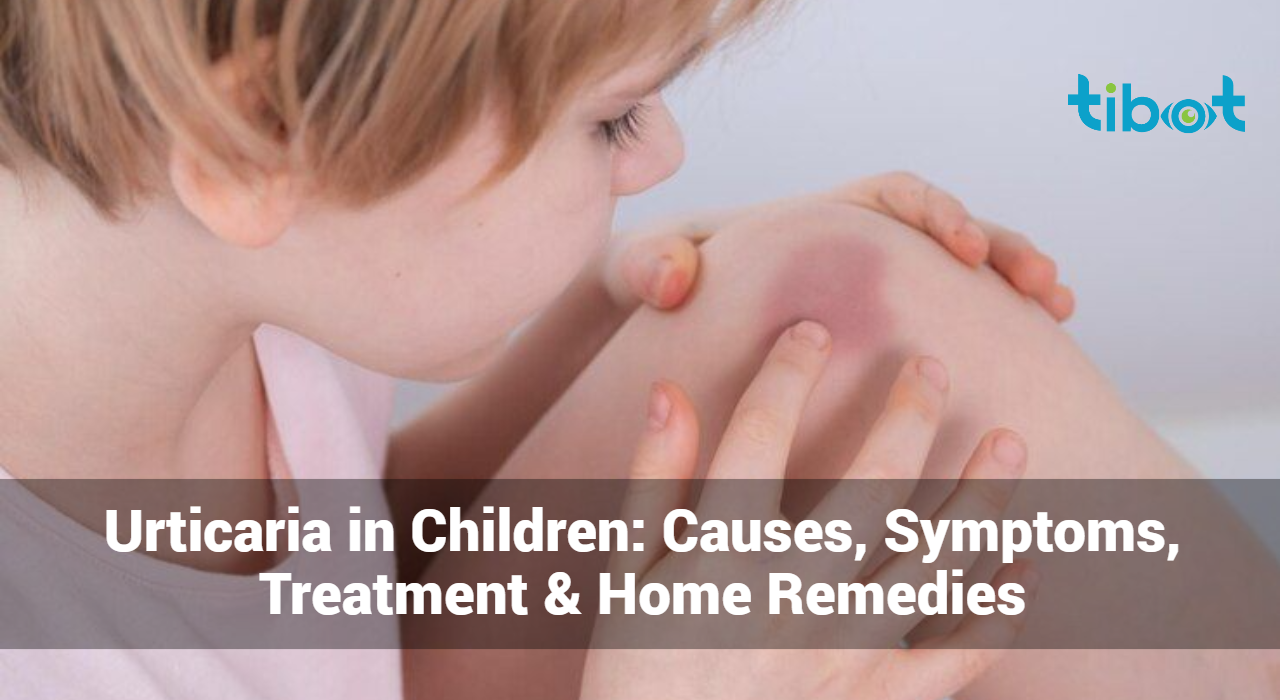Urticaria in Children: Causes, Symptoms, Treatment & Home Remedies

Urticaria, commonly known as hives, is a skin condition characterized by red, itchy welts that can appear anywhere on the body. While urticaria can affect people of all ages, it is particularly common in children. Understanding the causes, symptoms, treatment options, and home remedies for urticaria in children is essential for parents and caregivers to manage this condition effectively. This comprehensive guide provides valuable insights into urticaria, focusing on its impact on children and how to alleviate their discomfort.
What Is Urticaria in Children?
Urticaria in children presents as raised, red or pink welts on the skin that often itch intensely. These welts can vary in size and shape and may appear and disappear rapidly. Urticaria can be acute, lasting less than six weeks, or chronic, persisting for more than six weeks. It can also occur in response to various triggers, including allergens, infections, medications, and environmental factors.
Causes of Urticaria in Children
Identifying the cause of urticaria in children can be challenging, as it can result from multiple factors. Common causes include:
- Allergic Reactions: Allergens such as foods (e.g., nuts, eggs, milk), insect bites, pollen, and pet dander can trigger urticaria in sensitive children.
- Infections: Viral, bacterial, and fungal infections can cause urticaria. Common infections associated with urticaria include the common cold, strep throat, and urinary tract infections.
- Medications: Certain medications, including antibiotics, nonsteroidal anti-inflammatory drugs (NSAIDs), and aspirin, can cause allergic reactions leading to urticaria.
- Physical Factors: Physical triggers such as heat, cold, pressure, and sunlight can induce urticaria in some children.
- Stress: Emotional stress and anxiety can sometimes trigger or exacerbate urticaria.
- Chronic Conditions: Underlying health conditions such as autoimmune diseases and thyroid disorders can contribute to chronic urticaria.
These welts can cause significant discomfort for children, including intense itching. Understanding the common symptoms of urticaria in children is essential for early identification and management of this condition. Here are the most prevalent symptoms associated with urticaria in children:
1. Red or Skin-Colored Welts
- Appearance: Urticaria is marked by raised, red or skin-colored welts (also known as wheals) that can vary in size from small spots to large patches.
- Location: These welts can appear anywhere on the body, including the face, neck, arms, legs, and trunk.
- Shape and Size: Welts can be round, oval, or irregularly shaped and can range in size from a few millimeters to several centimeters. They can also merge to form larger areas of affected skin.
2. Intense Itching
- Primary Symptom: Itching is often the most distressing symptom of urticaria. It can be intense and persistent, leading to significant discomfort for the child.
- Worsening at Night: Itching may become more pronounced at night, interfering with the child’s sleep and overall well-being.
3. Swelling (Angioedema)
- Deeper Layers: In some cases, urticaria can cause swelling in the deeper layers of the skin, known as angioedema. This typically affects areas such as the lips, eyelids, hands, feet, and genitals.
- Rapid Onset: Swelling can occur suddenly and may be accompanied by a feeling of tightness or discomfort in the affected areas.
- Duration: Angioedema can last longer than typical welts, sometimes persisting for several days.
4. Rapid Appearance and Disappearance
- Transient Nature: One of the hallmark features of urticaria is the rapid onset and resolution of welts. Welts can appear suddenly, often within minutes, and may disappear just as quickly, only to reappear elsewhere on the body.
- Changing Locations: The welts may move around the body, with new welts appearing as old ones fade, creating a shifting pattern of affected areas.
5. Burning or Stinging Sensation
- Additional Sensations: Some children may experience a burning or stinging sensation in the affected areas, adding to the discomfort caused by itching.
- Localized Pain: In cases of severe urticaria or angioedema, the affected areas may be tender or painful to the touch.
6. Flushing and Redness
- Skin Changes: The skin around the welts may appear flushed or red, particularly if the child scratches the affected areas.
- Inflammation: The redness is due to inflammation and increased blood flow to the affected skin.
7. Fatigue and Irritability
- Impact on Well-being: The persistent itching and discomfort can lead to fatigue, irritability, and difficulty sleeping, affecting the child’s overall mood and behavior.
- Interference with Activities: Severe or chronic urticaria can interfere with the child’s daily activities, school attendance, and social interactions.
8. Systemic Symptoms (Rare)
- Severe Reactions: In rare cases, urticaria can be part of a severe allergic reaction known as anaphylaxis, which requires immediate medical attention. Symptoms of anaphylaxis include difficulty breathing, swelling of the throat, dizziness, and a drop in blood pressure.
- Additional Symptoms: Systemic symptoms such as fever, joint pain, or gastrointestinal issues may indicate an underlying condition and should be evaluated by a healthcare provider.
Recognizing the common symptoms of urticaria in children is crucial for early diagnosis and effective management. While urticaria can be distressing due to intense itching and discomfort, it is often manageable with appropriate treatment and care. If you suspect your child has urticaria, consult a healthcare provider for a proper evaluation and tailored treatment plan.
Diagnosis of Urticaria in Children
Diagnosing urticaria in children involves a thorough clinical evaluation and, in some cases, additional tests:
- Medical History: A detailed medical history, including recent illnesses, medications, and potential allergen exposure, helps identify possible triggers.
- Physical Examination: A healthcare provider will examine the child’s skin and assess the characteristics of the welts.
- Allergy Testing: Skin prick tests or blood tests may be conducted to identify specific allergens responsible for the reaction.
- Blood Tests: Blood tests can help rule out underlying conditions such as infections or autoimmune disorders.
- Skin Biopsy: In rare cases, a skin biopsy may be performed to rule out other skin conditions.
Analyze Skin Diseases
Use our AI chatbot to determine your skin condition
Treatment of Urticaria in Children
Effective treatment of urticaria in children aims to relieve symptoms and address the underlying cause. Treatment options include:
- Antihistamines: Over-the-counter or prescription antihistamines are commonly used to reduce itching and inflammation. Non-drowsy antihistamines are preferred for daytime use.
- Corticosteroids: In severe cases, short-term use of oral corticosteroids may be prescribed to reduce inflammation.
- Avoiding Triggers: Identifying and avoiding known triggers, such as specific foods or environmental factors, can help prevent urticaria flare-ups.
- Cool Compresses: Applying cool compresses to the affected areas can provide relief from itching and reduce swelling.
- Moisturizers: Regular use of hypoallergenic moisturizers can help soothe the skin and prevent dryness.
- Medication Adjustment: If urticaria is caused by medication, discontinuing or changing the medication under medical supervision may be necessary.
Home Remedies for Urticaria in Children
In addition to medical treatment, several home remedies can help manage urticaria in children:
- Oatmeal Baths: Adding colloidal oatmeal to a lukewarm bath can soothe itching and reduce inflammation.
- Aloe Vera: Applying aloe vera gel to the affected areas can provide cooling relief and reduce itching.
- Baking Soda Paste: A paste made from baking soda and water can be applied to the welts to alleviate itching and discomfort.
- Calamine Lotion: Calamine lotion can be applied to the skin to relieve itching and irritation.
- Herbal Teas: Herbal teas such as chamomile or peppermint can have calming effects and may help reduce stress-related urticaria.
- Dietary Changes: Eliminating potential food allergens from the child’s diet and incorporating anti-inflammatory foods can help manage symptoms.
Preventing Urticaria in Children
Preventing urticaria involves proactive measures to avoid known triggers and maintain overall skin health:
- Allergen Avoidance: Keep a diary to identify and avoid specific allergens that trigger urticaria in your child.
- Skin Care: Use gentle, hypoallergenic skincare products to avoid irritation. Moisturize regularly to keep the skin hydrated.
- Stress Management: Encourage stress-reducing activities such as deep breathing exercises, yoga, or engaging in hobbies.
- Healthy Diet: Provide a balanced diet rich in fruits, vegetables, and whole grains to support overall health and immune function.
- Environmental Control: Minimize exposure to extreme temperatures and environmental irritants that can trigger urticaria.
Conclusion
Urticaria in children can be a distressing condition, but with proper understanding and management, it is possible to alleviate symptoms and improve the quality of life for affected children. By recognizing the causes and symptoms of urticaria, seeking appropriate medical treatment, and utilizing effective home remedies, parents and caregivers can help their children navigate this condition with greater ease. Preventive measures and ongoing care are essential in minimizing the impact of urticaria and ensuring the well-being of children.





